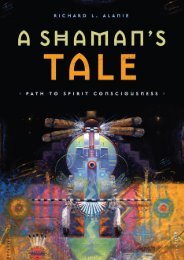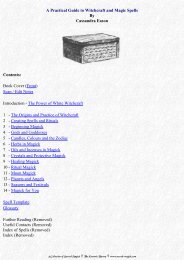Allan Kardec-THE Spirit's Book_ The Principles of Spiritist Doctrine (1989)
Entre los anos 1830 y 1857. Allan Kardec fue un hombre que amaso las mas grandes riquezas de "Material-dado por espiritus" que jamaz se hayan asemblado. El compilo y organizo esta vasta cantidad de informacion que se relaciona y toca con el aqui y hora, cuan inmensos son. Divinas y terrenales leyes , los reinos de los espiritus. El despues y el mas alla. Estos forman sus escrituras y son la fundacion para el " Movimiento Muldial-Internacional Espiritista." El libro de los espiritus. He aqui la version de 1989.
Entre los anos 1830 y 1857. Allan Kardec fue un hombre que amaso las mas grandes riquezas de "Material-dado por espiritus" que jamaz se hayan asemblado. El compilo y organizo esta vasta cantidad de informacion que se relaciona y toca con el aqui y hora, cuan inmensos son. Divinas y terrenales leyes , los reinos de los espiritus. El despues y el mas alla.
Estos forman sus escrituras y son la fundacion para el " Movimiento Muldial-Internacional Espiritista."
El libro de los espiritus. He aqui la version de 1989.
Create successful ePaper yourself
Turn your PDF publications into a flip-book with our unique Google optimized e-Paper software.
106<br />
ALLAN KARDEC<br />
the term, lacks this essential condition <strong>of</strong> theoretic soundness. It was natural that the religious belief <strong>of</strong><br />
peoples Who, knowing nothing <strong>of</strong> the attributes <strong>of</strong> God, were backward enough to admit the existence <strong>of</strong><br />
maleficent deities, should also admit the existence <strong>of</strong> demons but, on the <strong>of</strong> those who acknowledge the<br />
goodness <strong>of</strong> God to be His distinguishing quality, it is illogical and contradictory to suppose that He can<br />
have created beings doomed to evil. and destined to do evil for ever, for such a supposition is the negation<br />
<strong>of</strong> His goodness. <strong>The</strong> partisans <strong>of</strong> the belief in devils appeal to the words <strong>of</strong> Christ in support <strong>of</strong> their<br />
doctrine and it is certainly not we who would contest the authority <strong>of</strong> His teachings, which we would faint<br />
see established, not merely on the lips <strong>of</strong> men, but also in their hearts. But are those partisans quite sure<br />
<strong>of</strong> the meaning attached be Him to the word "devil"? Is it not fully admitted that the allegorical form is<br />
one <strong>of</strong> the distinctive characteristics <strong>of</strong> His utterances, and that the Gospels contain many things which<br />
are not to be taken literally? To prove that such is the case, we need only quote the following passage: -<br />
"Immediately after the tribulation <strong>of</strong> those days the sun shall be darkened,and the moonshall not give<br />
her light, and the stars shall fall from heaven. and the powers <strong>of</strong> the heavens shall be shaken And then<br />
shall appear the sign <strong>of</strong> the Son <strong>of</strong> Man in heaven... Verily I say unto you. This generation shall not pass<br />
till all these things are fulfilled" (Matt. xxiv. 29, 30, 34.) Have we not seen that theform <strong>of</strong> the biblical<br />
text, in reference to the creation and movement <strong>of</strong> the earth, is contradicted by the discoveries <strong>of</strong> science?<br />
May it not be the same in regard to certain figurative expressions employed by Christ in order to adapt<br />
His teachings to the time and the scene <strong>of</strong> His mission? Christ could not have made a statement knowing it<br />
to be false. If, therefore, His sayings contain statements which appear to be contrary to reason, it is<br />
evident either that we do not understand their meaning or that we have interpreted them erroneously.<br />
Men have done in regard to devils what they have done in regard to angels. Just as they have imagined<br />
that there are beings who were created perfect from all eternity. so they have imagined that spirits <strong>of</strong> the<br />
lower degrees Were beings essentially and eternally bad. <strong>The</strong> wordsdemon, devil, ought, therefore, to be<br />
understood as indicating impure spirits who are <strong>of</strong>ten no better that the imaginary beings designated by<br />
those names, but with this difference. viz., that their state <strong>of</strong> impurity and inferiority is only transitory.<br />
<strong>The</strong>y are the Imperfect spirits who rebel against the discipline <strong>of</strong> trial to which they are subjected, and<br />
who, therefore, have to undergo that discipline for a longer period, but who will, nevertheless, reach the<br />
goal in time, When they shall have made up their minds to do so. <strong>The</strong> words demon, devil, might<br />
accordingly be employed in this sense but as they have come to be understood exclusively as conveying the<br />
meaning now shown to be false. their employment might lead into error by seeming to recognise the<br />
existence <strong>of</strong> beings specially created for evil.<br />
As regards the term "Satan," it is evidently a personification <strong>of</strong> the principle <strong>of</strong> evil under an allegorical<br />
form for it is impossible to admit the existence <strong>of</strong> a being who fights against God as an independent and<br />
rival power, and whose sole business in life is to contravene His designs. As images and figures are<br />
necessary in order to strike the human imagination, men have pictured to themselves the beings <strong>of</strong> the<br />
incorporeal world under a material form. with attributes indicative <strong>of</strong> their good or bad qualities. It is<br />
thus that the ancients, wishing to personify the idea <strong>of</strong> time, represented it under the figure <strong>of</strong> an old man<br />
with a scythe and an hour-glass. To have personified it under the figure <strong>of</strong> a youth would have been<br />
contrary to common sense. <strong>The</strong> same may be said <strong>of</strong> the allegories <strong>of</strong> Fortune, Truth, etc. <strong>The</strong> moderns<br />
have represented the angels or pure spirits under the form <strong>of</strong> radiant beings with white Wings-emblem <strong>of</strong><br />
purity Satan, with horns, claws, and the attributes <strong>of</strong> bestiality-emblems <strong>of</strong> the lowest Passions; and the<br />
vulgar, prone to understand such representations literally, have taken these allegorical embodiments <strong>of</strong><br />
abstract ideas for real personalities, as they formerly did in regard to the allegorical personifications <strong>of</strong><br />
the old mythology.











